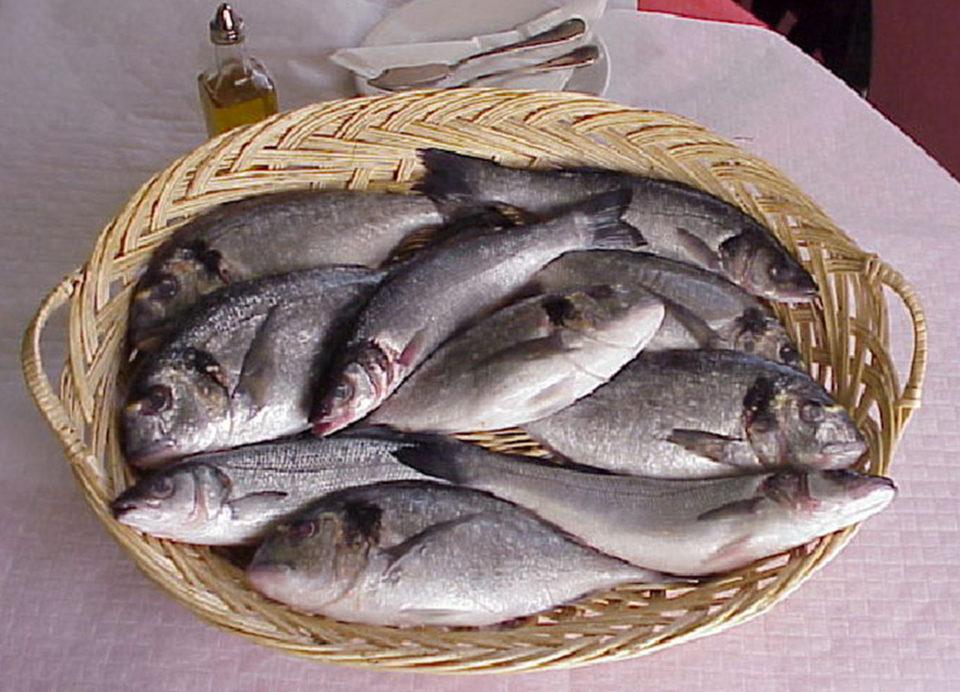
Gilthead sea bream and European sea bass are major aquaculture species in Mediterranean Europe.
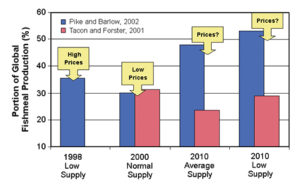
As the aquaculture industry continues to grow, the demand for fishmeal and fish oil as major ingredients in aquafeeds for carnivorous fish and marine shrimp also grows. These key ingredients are not only excellent sources for highly digestible protein and energy, but also provide essential amino acids and fatty acids, liposoluble vitamins, phospholipids, cholesterol and trace and macro minerals.
Availability and price
Various authors have projected global demands for fishmeal and fish oil for aquafeed production. One of the critical parameters in these projections is the future inclusion of fishmeal and fish oil in aquafeeds.

A moderate reduction in their use (Pike and Barlow, 2000) would result in continuously high pressure on the fishmeal and fish oil market, and even a shortage in years of low production (Figs. 1, 2). A more optimistic prediction was made by Tacon and Forster (2001), who assumed a drastic reduction in fishmeal and fish oil inclusions in the coming decade – due to consumer pressure and market forces – would result in acceptable supply/demand ratios for the ingredients (Figs. 1, 2).
Fishmeal and fish oil prices have shown great fluctuations during the past decade. Prices for the products in Europe were about U.S. $400 per MT in late 1994, rose over $700 per metric tons (MT) in 1998, fell below $350 per MT in 1999, and are now close to U.S. $600 per MT. The continuous expansion of aquaculture puts pressure on ingredient prices, especially during periods of low supply.
Fishmeal and fish oil replacements
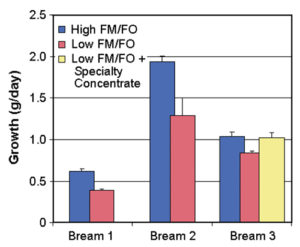
As an alternative to increasing prices, lower inclusions of fishmeal and fish oil in feeds present a challenge for the aquafeed industry. The range of alternative protein and fat sources for marine fish feeds are limited when relative cost-efficiency, consumer acceptance, and nutritional/physical acceptability are taken into consideration. Although animal byproducts offer interesting nutritional alternatives for carnivorous fish feeds, their use is not acceptable by large European supermarkets and is prohibited by current European Union legislation.
A current solution to the problem of high fishmeal and fish oil prices is their partial replacement by vegetable protein and fat sources. These sources, however, have numerous disadvantages, including low nutrient densities, antinutritional factors, high carbohydrate content, imbalanced amino acid and fatty acid profiles, low palatability, and others.
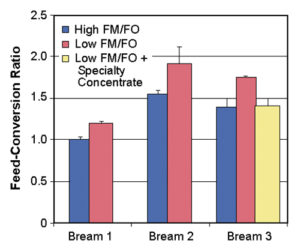
The limited knowledge currently available regarding nutritional requirements, interactions, and bioavailability of nutrients does not allow a direct replacement of fishmeal and fish oil by vegetable sources. The authors documented this in trials with gilthead sea bream (Sparus aurata) at the INVE test center in Cadiz, Spain from September 2000 to December 2002. A trial with European sea bass (Dicentrarchus labrax) was conducted in September 2000 in collaboration with Ifremer, France. These two major marine aquaculture species in Mediterranean Europe that reflected production of over 140,000 MT in 2000.
Experimental design
Four trials were carried out: three with sea bream (Bream 1-3) and one with sea bass (Bass 1). The experimental design is summarized in Table 1. All fish were fed to satiation by hand except in Bream 3, where fish were slightly overfed using automatic belt feeders. Excess feed was collected and feed intake adjusted. Nitrite, ammonia, nitrate and pH were kept within tolerance limits for the species.
Ceulemans, Experimental design for feed trials, Table 1
| Bream 1 | Bream 2 | Bream 3 | Bream 4 |
|---|
Bream 1 | Bream 2 | Bream 3 | Bream 4 | |
|---|---|---|---|---|
| Tank volume (l) | 350 | 3,500 | 350 | 50 |
| Initial weight (g) | 20 | 130 | 49 | 6.3 |
| Fish stocked/tank | 30 | 100 | 35 | 40 |
| System | Recirc. | Flow-thru | Recirc. | Flow-thru |
| Duration (days) | 42 | 75 | 170 | 49 |
| Replicas/treatment | 3 | 3 | 2 | 3 |
| Avg. Temp. (° C) | 22 | 22 | 22 | 21.8 |
Experimental diets
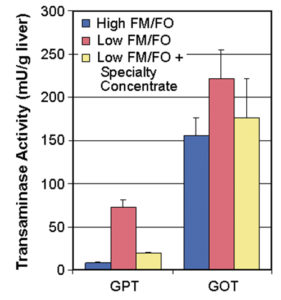
The experimental fish were fed a control diet (High FM/FO) in which the largest part of the crude fat and protein originated from fishmeal and fish oil, 65-88 percent and 67 percent, respectively. In a second diet (Low FM/-FO), the fishmeal and fish oil were partly replaced by vegetable meals and oils so that only 25 percent of the dietary protein and 31 to 46 percent of the dietary fat came from the marine ingredients.
All diets where formulated to contain 48 percent protein and 17 percent fat, except for Bream 3, where the protein:fat ratio was 46:18. The experimental feeds were cooked-extruded using common marine and vegetable meals and oils (herring meal, soybean flour, soybean meal, wheat gluten, corn gluten, wheat flour, fish oil, soybean oil and 1 percent vitamin-mineral premix).
Feeding low-fishmeal and low-fish oil diets
In the bream trials, it was evident that drastic replacement of fishmeal and fish oil by standard vegetable ingredients without nutritional compensation significantly reduced feed performance for marine fish. Results showed reduced daily growth rates (10 to 28 percent, Fig. 3), increased feed-conversion rates (+20 to 24 percent, Fig. 4), increased fat infiltration in the liver (+34 percent) and a higher hepatosomatic index (+9 percent).
These numbers were largely confirmed by similar findings in the bass trial (Fig. 6). Furthermore, a sharp increase in liver transaminase activities (Fig. 5) in sea bass fed Low FM/FO diets indicated a nutritional imbalance that resulted in 8 percent greater fat deposition in the liver.
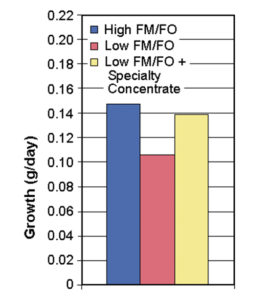
of tested sea bass.
Although diets with low fishmeal/fish oil content can be formulated to satisfy basal nutritional requirements, their performance is bound to be inferior to diets with greater marine inclusion due to the higher level and/or availability of nutrients in fishmeal and fish oil, and possible nutritional side effects of using vegetable raw materials.
Nutritional compensation
The supplementation of a specialty concentrate (Fish Essence, INVE Aquaculture Nutrition) providing a balanced nutrient package of vitamins, minerals, attractants, amino acids, phospholipids, and essential fatty acids to the Low FM/FO feed improved growth and feed utilization in both fish species (Figs. 3-6) to a level comparable to that of the control group. Furthermore, the nutritional fortification counteracted the enhancement of transaminase activities and increased lipid deposition in the liver observed in sea bass fed the diet with low fishmeal and fish oil content.
Product quality
The Bream 2 trial resulted in reduced fat content in the muscle and also reverted the omega-6:omega-3 ratio from 0.5 to 1.3 compared to the control group (Fig. 7). These changes could effect the end product quality.
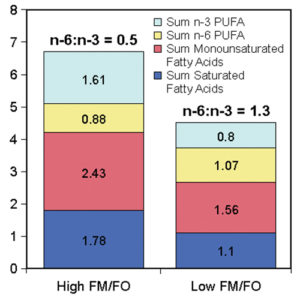
The administration of specific finishing diets containing high levels of fishmeal and fish oil during the last months before harvesting may revert the nutritional value of farmed species to their marine profiles. Such diets, however, would significantly limit the potential for fishmeal/fish oil replacement for these two fish species, which receive 25 to 30 percent of their total feed during the last months of production.
Conclusion
Further growth of the aquaculture industry will likely result in increased demand and a possible shortage of marine raw materials in the coming decade. To avoid increases in formulation costs, reductions in fishmeal and fish oil inclusion levels are necessary.
In many commercial species, a drastic replacement of fishmeal and fish oil by vegetable protein and fat sources can affect growth, food conversion, liver function, and quality of the final product. Supplementing with appropriate nutrients and attractants can compensate for nutritional imbalance and palatability loss. Finishing diets may improve the final product quality of fish grown on diets with low levels of fishmeal and fish oil.
(Editor’s Note: This article was originally published in the February 2003 print edition of the Global Aquaculture Advocate.)
Now that you've reached the end of the article ...
… please consider supporting GSA’s mission to advance responsible seafood practices through education, advocacy and third-party assurances. The Advocate aims to document the evolution of responsible seafood practices and share the expansive knowledge of our vast network of contributors.
By becoming a Global Seafood Alliance member, you’re ensuring that all of the pre-competitive work we do through member benefits, resources and events can continue. Individual membership costs just $50 a year.
Not a GSA member? Join us.
Authors
-
-
-
R. Robles Arozarena
CASEM, Universidad de Cadiz, Puerto Real, Spain
Tagged With
Related Posts
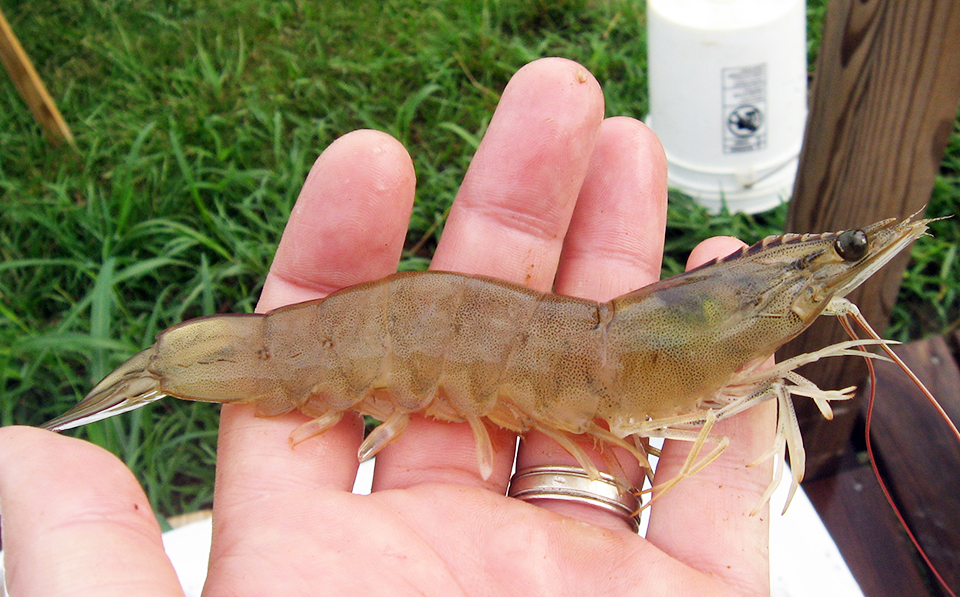
Aquafeeds
Alternatives to fishmeal perform well in low-salinity shrimp farm trial
In a white shrimp farm trial in a low-salinity environment, alternatives to fishmeal did not negatively impact the growth, survival or FCR of the shrimp.
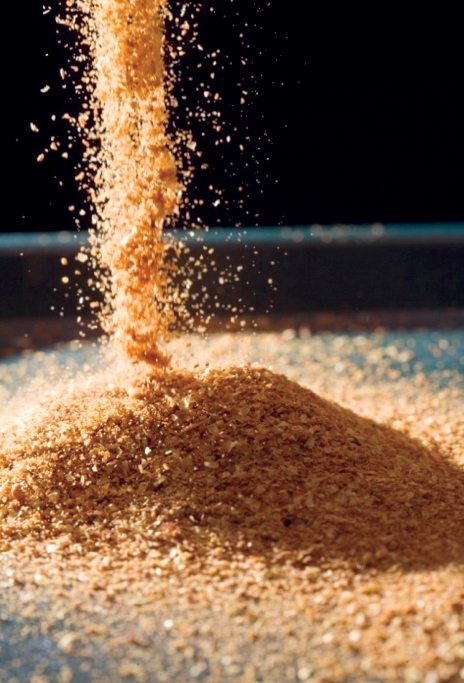
Aquafeeds
A look at corn distillers dried grains with solubles
Corn distillers dried grains with solubles are an economical source of energy, protein and digestible phosphorus to reduce feed costs and fishmeal usage.

Aquafeeds
A look at protease enzymes in crustacean nutrition
Food digestion involves digestive enzymes to break down polymeric macromolecules and facilitate nutrient absorption. Enzyme supplementation in aquafeeds is a major alternative to improve feed quality and nutrient digestibility, gut health, compensate digestive enzymes when needed, and may also improve immune responses.
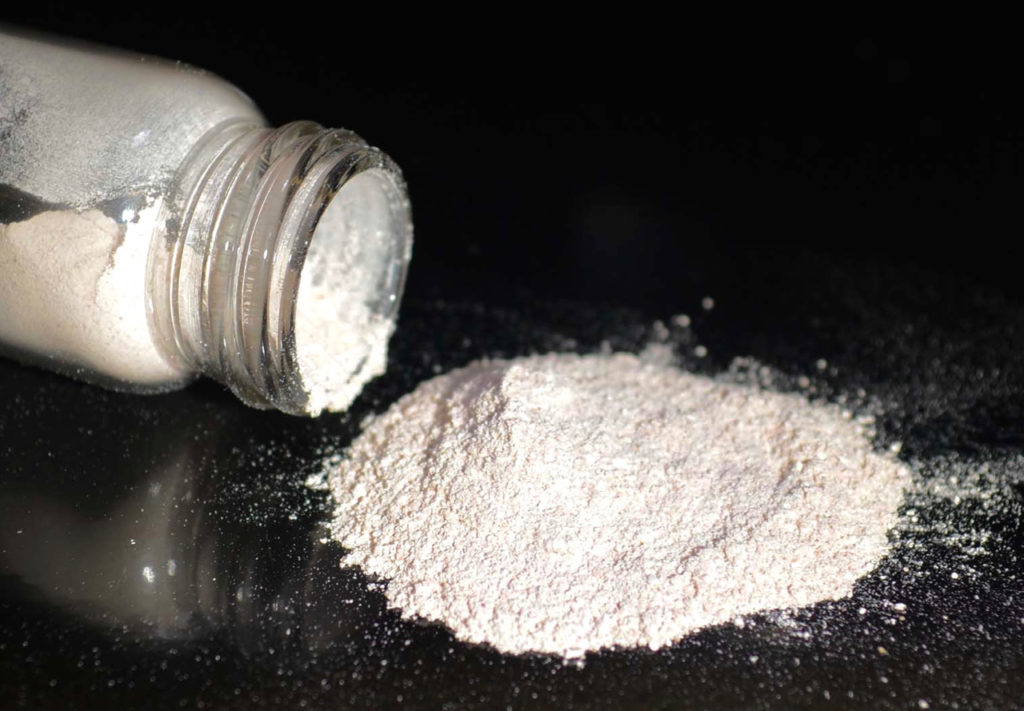
Aquafeeds
A new nutrient for aquaculture, from microbes that consume carbon waste
Biotechnology firm NovoNutrients aims to produce a line of nutraceutical aquafeed additives as well as a bulk feed ingredient that can supplement fishmeal. Its process includes feeding carbon dioxide from industrial gas to a “microbial consortium” starring hydrogen-oxidizing bacteria.



